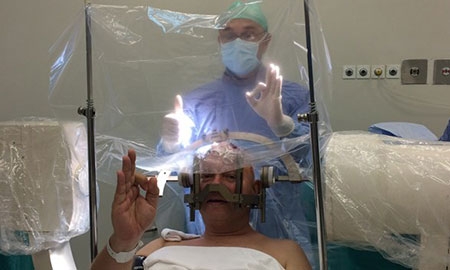Neurosurgeon Dr. Ali Zırh operated on the patient with local anesthesia, while talking to his 47-year-old patient, Vilkoshevski, at the same time. The courageous patient, who is an electrical engineer and a keen diver, probably took the most intriguing selfie that has been ever taken. He hit the release button while Dr. Zırh was placing the electrode in his brain towards the end of the surgery.
Electrical engineer Vilkoshevski, who lives in İzmir, has been struggling with Parkinson’s disease for approximately five years. His illness changed his life completely, and he had to give up his two passions in life: diving and photography. He could not even drive a car. Vilkoshevski said that many aspects of his life had become extremely difficult in the five years since the onset of the disease, and he wanted to immortalize his struggle by taking the selfie during surgery, hoping that it might raise awareness of the condition.
Using his camera to show that the debilitating disease had not defeated him, Vilkoshevski also said that, “Due to this disease, I had to give up many of my passions in life such as diving and underwater photography. I could not do any of these anymore. My hands would shake. I would suffer attacks and my body would stiffen. Dr. Ali Zırh told me that I could go back to the relatively healthy state that I was in during the first years of the disease if I had surgery to insert a brain pacemaker. When the first part of the surgery (which entails the placement of the electrodes in the patients brain while they are conscious) was successfully completed, I felt obliged to my fiends and family that I was feeling fine.
“During those few minutes before I went under anesthesia, I wanted to take a selfie to let my wife know that I was fine, because people believe what they see with their own eyes more than what they hear. In the end, I had gone through surgery without any problems – while I was laughing, telling jokes and sharing my feelings with my doctor. In fact, taking photos of my own surgery without any pain during the final stages of brain surgery gave a new lease of live to my photography, which I had had to stop for years. As we are using this technology in our daily lives in ordinary situations, I asked myself ‘why shouldn’t we use it to share information of vital importance and while so many people are waiting to hear from you?’ When Dr. Ali Zırh allowed me to take a selfie, we could send an enormous ‘I am fine’ message to my loved ones.
Having recovered from his brain pacemaker surgery, Julian Vilkoshevski said that he felt reborn and that he will resurrect his passion for photography. His biggest dream is to go sailing with his wife, in the sailing boat they had bought with so much enthusiasm before he was diagnosed with the condition.
Medical Park Bahçelievler Hospital Brain and Neurosurgery Specialist Dr. Ali Zırh, who operated on Mr. Vilkoshevski, said, “When we implanted the brain pacemaker, we simultaneously placed two electrodes into specific parts of the brain. With a method called the Microelectrode Recording and Simulation Technique, where we can monitor to the electrical activity of a single cell in the brain, our objective is to determine the location of the cells responsible for the disease and the surrounding tissue. For this, we operate while the patient is awake and conscious, which means that he/she can talk during the operation. This allows us to measure the patient’s reactions and makes it easier for us to identify the part of the brain that is causing the problem. During the first two to three hours of surgery, the patient is awake and we ask the patient to make certain movements and actions. The disease can be reverted back to its earlier, milder stages with the help of the insertion of the pacemaker, allowing patients to live normal lives. Put differently, the brain pacemaker turns back the time. Sometimes, patients that cannot live alone and cannot even hold a spoon prior to the surgery get back their freedom.”

0 COMMENTS